Technology Projects
- Hybrid Solar Thermoelectric and Photovoltaic Energy Conversion
- Hydrodynamics of Wave-Power Extraction
- Low-Lift-Optimized Plant, Advanced Transport, and Predictive Controls for Efficient Cooling
- Renewable Energy and Fuels from Waste: Thermochemical Pathways
- Towards Very High-Performance Thin Film Photovoltaic Cells: Designs and Implementations
- Upgrading Cellulosic Resources as Specialty Polymers
- Water Treatment and Electricity Generation Using Renewable Materials
Systems Projects
- Commercial Aviation in a Carbon Constrained Future: Effective Technological, Operational and Policy Responses from an Enterprise of Enterprises View
- A High Efficiency and Environmentally Friendly Nuclear Reactor for Electricity and Hydrogen
- Integration of Renewable Energy Sources in Power Systems - Electricity Markets and Microgrid Reliability
- Technology Forecasting Using Data Mining and Semantics
- Requirements Engineering for Sustainable Systems
- Greening the Supply Chains: Optimization Models and Solution Algorithms
- Intelligent Devices for Smart Power Grids
Policy Projects
- The Development of Innovative Industries and the Role of Public Research Institutions: the Case of Renewable Energy
- Integration of Renewable Energy Sources in Power Systems
- Modeling and Predicting the Impact of Climate Change on Health in the Middle East, South Asia, and Africa
- Modeling Technology Policy for Energy and Water: Applications and Extensions of System Dynamics
Technology Projects
Hybrid Solar Thermoelectric and Photovoltaic Energy Conversion
We are investigating hybrid technology that combines photovoltaics with thermoelectrics to convert solar light into electric energy at a low cost. Hybrid systems aim to fully harness the energy embedded in the incoming solar radiation by combining a photovoltaic (PV) module with its narrow absorption wavelength range with a thermoelectric (TE) generator characterized by constant conversion efficiency in the whole solar radiation spectrum.
 Principal Investigator at MIT:
Principal Investigator at MIT:
Professor Gang Chen
 Principal Investigator at Masdar Institute:
Principal Investigator at Masdar Institute:
Assistant Professor Matteo Chiesa
Research Objectives
- Solar TE modelling and cell fabrication.
- Design modelling and fabrication of frequency selective surfaces.
- Design and fabrication of a high efficiency, low cost hybrid system.
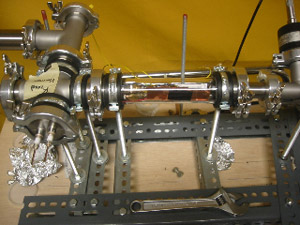
Impact on Global Sustainability
- Novel approach to convert solar radiation into electricity in a cost effective way.
- Development of technology for the conversion of sustainable energy sources that can be shortly introduced into the market.
Approach
System design and optimization needs will be carried out to determine the devices and system configurations. The modeling will provide guidance for experiments.
Accomplishments
- Developed a methodology of the design of high performance hybrid system.
- Constructed a solar thermoelectric generator prototype and performance tests are in progress.
- Explored the effect of surface plasmons from a theoretical and experimental point of view for the development of frequency selective surfaces.
- Developed a general method to predict the performance of combined STG and PV.
- Purchased a solar simulator with an external grant from NFR.
- Improved STG testing rigs and testing of STGs.
- Addressed challenges related to the contact resistance
- Developed selective surfaces via modeling, fabrication, and testing.
- Characterized phonon transport in thermoelectric materials using pump-and-probe technique.
Last updated 9/10/2008 Back to Top
Hydrodynamics of Wave-power Extraction
This research is focused on the extraction of mechanical energy from ocean surface waves, without including the specifics of mechanical to electrical energy conversion, to predict wave power absorption rate, wave forces on and motion of wave-energy absorbers.
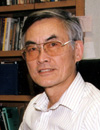 Principal Investigator at MIT:
Principal Investigator at MIT:
Professor Chiang C. Mei
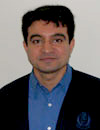 Principal Investigator at Masdar Institute:
Principal Investigator at Masdar Institute:
Assistant Professor Ali Tabaei
Research Objectives
To construct mathematical models to predict the hydrodynamic aspects of two types of wave-energy absorbers, buoys and oscillating water columns, in the following areas:
- mutual interaction of neighboring absorbers in a wave farm, which is an array of many point absorbers,
- energy loss in the neighborhood of absorbers,
- nonlinearity of waves and absorber motion,
- randomness of waves, and
- variation of sea depth.
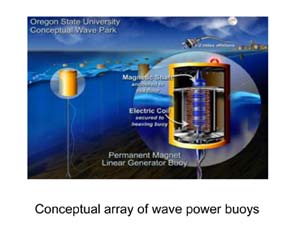
Impact on Global Sustainability
- Optimum design of wave energy devices as well as wave farms.
- Applications in offshore structures supported by an array of piles.
Approach
Employing theoretical fluid dynamics, wave theories, perturbation and asymptotic methods, we are currently investigating absorber arrays, dissipation loss in the neighborhood of the absorbers, and absorbers of buoy type with internal mass(es). As a first step, the linear dynamics of a single buoy is studied to find the added mass and radiation damping coefficients as well as the force due to diffraction.
For accurate prediction of net wave power absorption, realistic estimation of dissipation loss is essential. To examine the effect of friction on waves, we have extended the asymptotic theory of Li & Mei (2007)[1] for resonant scattering of water waves by an array of fixed vertical cylinders. To account for the effect of dissipation, we impose a fictitious boundary condition on the cylinder walls which can be adjusted to treat the dissipation in the turbulent boundary layer on the structural surface.
Progress
- Analytical study of linear dynamics of a point absorber of buoy type
- Examining the effect of energy loss on resonant scattering by an array of vertical piles.
[1] Y. Li and C. C. Mei. Multiple resonant scattering of water waves by a two-dimensional array of vertical cylinders: Linear aspects. Physical review E, 76:016302, 2007
Last updated 9/10/2008 Back to Top
Low-Lift-Optimized Plant, Advanced Transport, and Predictive Controls for Efficient Cooling
Cooling accounts for about 15% of energy use in modern buildings and a much higher percentage (20-30%) in warm climates. Therefore, the world's cooling energy needs must be addressed on two fronts: design buildings to reduce cooling loads and devise ways cool them more efficiently. This project will assess four highly complementary paths by which cooling systems can be made more efficient: (1) reduce motor, fan, pump, and compressor losses; (2) obtain closer heat-exchanger approach temperatures, (3) improve transport efficiency, and (4) make system and operational changes to reduce condensing temperatures (night operation) and raise evaporating temperatures (radiant cooling).
 Principal Investigators at MIT:
Principal Investigators at MIT:
Professor Leon Glicksman and Leslie K. Norford

 Principal Investigator at Masdar Institute: Associate Professor Peter R. Armstrong
Principal Investigator at Masdar Institute: Associate Professor Peter R. Armstrong
Research Objectives
- Develop technology, design method, and controls to boost system efficiency 3 to 4 times.
- Extend to thermally actuated cooling/ dehumidification and demand response
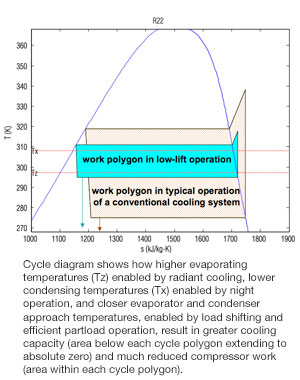
Impact on Global Sustainability
- Low-GWP path to improved living standard in fast-growing economies.
- Demand relief and improved load factor for electric utilities.
- Cost-effective path to PV- and solar-thermal powered cooling.
Approach
Compressors, fans, and pumps are characterized over a range of speed and loading conditions and the characteristics are used to implement optimal chiller system controls. The resulting chiller performance function is then used to implement a 24-hour look-ahead controller that improves load factor by precooling at night. The combination of improved load factor and optimal variable flow control results in substantial part-load efficiency improvements and energy savings. The same control and forecast capabilities can be used for highly effective demand response functions. To properly implement load shifting, the controller must not only forecast internal gains and weather, but also maintain an accurate transient thermal response model of the conditioned space. Transfer functions representing the relation between temperature and heat rate trajectories and methods of identifying these transfer functions reliably from short-term observations are under development. Simulation models are validated by assembling and testing prototype hardware in a calorimeter test bench and an existing MIT test room. Full-scale demonstrations will be conducted in Masdar City.
Progress
- Variable-speed compressor and optimal chiller control models have been developed.
- Semi-physical compressor model that reflects changes in refrigerant compressibility over a wide range of pressure ratio and inlet conditions, and that properly accounts for internal heat transfer and friction and flow losses over a wide range of shaft speed has been published.
- A variable-speed chiller test stand with torque-speed and thermal controls is almost complete
- Simulations show savings of 70 to 74% in range (Houston to Chicago) of five climates.
Last updated 9/10/2008 Back to Top
Renewable Energy and Fuels from Waste: Thermochemical Pathways
The focus of this work is on energy conversion to generate clean, renewable fuel or electricity from a wide variety of feedstocks often considered as "waste" (e.g., refinery residual, municipal and industrial waste, and biomass). Gasification is an example of thermochemical technology and we examine this technology to convert the chemical energy stored in feedstocks to generate heat, fuels, and chemicals.
 Principal Investigator at MIT: Professor Ahmed Ghoniem
Principal Investigator at MIT: Professor Ahmed Ghoniem
 Principal Investigator at Masdar Institute: Assistant Professor Isam Janajreh
Principal Investigator at Masdar Institute: Assistant Professor Isam Janajreh
Research Objectives
- To achieve a radical improvement in the technology through analyses and development of advanced simulation.
- To develop predictive tools for thermochemical conversion to carry out systematic 0D, 2&3 D noncreative, and coupled CFD chemical kinetic flow.
- To utilize different waste streams and convert them into chemical energy in a laboratory scale pilot plant.
- To analyze the complex flow pattern of relevant multiphysics flow applications, i.e., boilers, gasifiers, and combustors as well as unsteady turbulent flow of wind turbine and atmospheric boundary layer flow.
Impact on Global Sustainability
- Create and enhance a renewable and sustainable energy source from refinery residuals, industrial waste, and biomass as well as boost the CC efficiency, i.e., IGCC and ISCCS, via cofiring, cogeneration, and optimization.
- Reduce the emission of CO2, SOx, and NOx and by producing clean transportation fuel from syngas at low energy penalty.
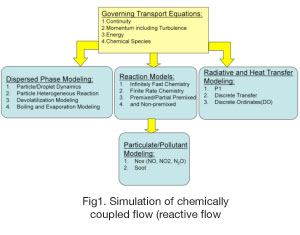
Approach
- Characterization of several Feedstock candidates by using proximate and ultimate analyses to estimate their enthalpy of reaction and elemental compositions.
- Apply conservative low and species transport to simulate the conversion processes of a candidate feedstock, including heating, draying, volatilization and combustion.
- Carry out numerical analysis utilizing CFD and heat transfer, where appropriate, and applied progressively to non-reacting flow and coupled two phase (continuous and discrete phase) flow.
- Carry out and investigate different coupled chemical kinetics of the discrete particles with the continuous phase, including mixture fraction, and species transport
- Integrating the coupled reactive flow into the balance of the plant and carry out process simulation.
- Validate particle and feedstock conversion by designing and conducting laboratory scale experiments utilizing laser diagnostic.
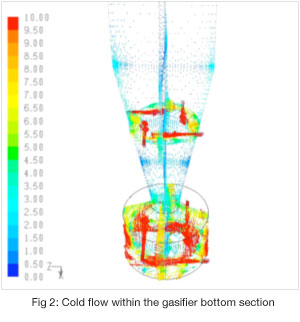
Accomplishments
- Thorough literature searches on zero-dimensional-modeling, the basis of gasification, and the governing conservation laws for detailed CFD/chemical kinetic coupling.
- Gasification systematic analyses for a baseline and industrial waste feedstocks: Computed mass and molar faction of the main product species (CO2, CO, H2O, H2, Ash).
- CFD modeling analyses for the non-reacting flow, and two phase discrete flow modeling, including model sensitivities, resolution (2D versus 3D), injected feedstock particle size and velocity.
- Coupled CFD chemical kinetic modeling analyses: volatile and combustion.
- Zero -dimension modeling of two examples of feedstocks: baseline (coal) and industrial waste (tire).
- Reactor geometry identification with CFD cold-flow analysis for the axisymmetrical and three-dimensional geometries.
- Introduction of discrete phase into the cold-flow and CFD analyses for the axisymmetrical and three-dimensional geometries.
- Simulate the combustion and gasification of coal particles via both species transport and mixture fraction
- Conducting process simulation of CC for further integration to systematic and coupled kinetic flow analyses to the gasifier (in progress).
Last updated 9/15/2008 Back to Top
Towards Very High-Performance Thin Film Photovoltaic Cells: Designs and Implementations
This collaborative research project focuses on three major research areas in thin-film and high efficiency photovoltaic technology:
- High-efficiency thin-film Si solar cells with novel light trapping;
- Ge-based thin-film thermophotovoltaic (TPV) cells with photon recirculation;
- AlGaAs/Si/Ge tandem solar cells for ultra-high efficiency energy conversion.
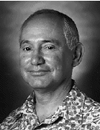 Principal Investigators at MIT: Professor L.C. Kimerling and Dr. J. Michel
Principal Investigators at MIT: Professor L.C. Kimerling and Dr. J. Michel

 Principal Investigator at Masdar Institute: Assistant Professor Mahieddine Emziane
Principal Investigator at Masdar Institute: Assistant Professor Mahieddine Emziane
Research Objectives
- Design and implement very high performance thin-film devices for PV, TPV and concentrator solar cells.
- Address the key technological challenges regarding these novel devices and their process integration
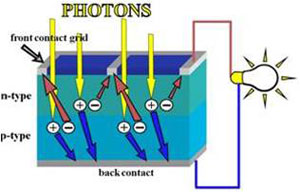
Impact on Global Sustainability
Applying finding of this research to commercial thin-film cells will enhance their performance, and make solar electricity generation cost-competitive, and sustainable through the use of small volume of row materials.
Approach
- To apply a new back-reflector concept to very thin crystalline, polycrystalline and amorphous Si solar cells.
- To develop monolithic TPV cells on a Ge epitaxial layer on Si wafers.
- To design and implement a tandem cell innovation based on (AlGaAs)/Si/Ge structures
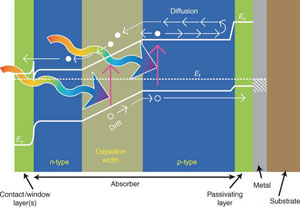
Progress
Following encouraging results from crystalline Si thin-film solar cells with light trapping scheme, the approach is now being applied to polycrystalline and amorphous thin-film Si solar cells.
Ge TPV cells are being implemented, and we are designing the Bragg reflector (which is a photonic bandgap filter) to be integrated with the optimized Ge TPV cell.
Through modeling and simulations, we are optimizing the device structure for tandem PV cell involving Si and Ge cells initially.
Last updated 9/15/2008 Back to Top
Upgrading Cellulosic Resources as Specialty Polymers
Cellulose is a sustainable natural polymeric raw material that can be obtained from diverse resources such as urban waste and biomass cultivation. Our research intends to investigate new methods of processing and novel application of this critical and renewable resource.
 Principal Investigator at MIT:
Principal Investigator at MIT:
Professor Charles Cooney
 Principal Investigator at Masdar Institute:
Principal Investigator at Masdar Institute:
Assistant Professor Raed Hashaikeh
Research Objectives
A new strategy of upgrading cellulosic waste and generating high quality cellulosic material will be developed. The research project will launch a program at the Masdar Institute focused on sustainable and green end products development from waste.
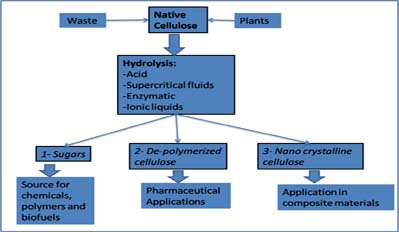
Impact on Global Sustainability
Worldwide, there is a growing movement to minimize the environmental impact of polymers and replace them with sustainable, eco-efficient and green materials. This research, once developed, would provide the foreseen sustainable society of Masdar city with environmentally safe materials.
Approach
Cellulosic waste produced at Masdar city and in Abu Dhabi will be hydrolyzed to extract fibers with preferred structure and modified properties. The extracted fibers will be explored in novel applications of interest to Abu Dhabi and Masdar city.
Three classes of products are envisioned:
- sugars
- depolymerized cellulose
- highly crystalline nanocellulose
The sugars are a valuable starting point for synthesis of biodegradable polymers, chemicals, and biofuels. The de-polymerized cellulose will be studied as a high value specialty product for use in multiple applications such as food and drug delivery. The cellulose nanocrystals will be utilized as a reinforcing material in selected biopolymeric matrices as an eco-efficient biodegradable material. As such, these materials represent another class of higher value materials that can be manufactured with cellulose as the renewable resource.
Last updated 8/27/2009 Back to Top
Water Treatment and Electricity Generation Using Renewable Materials: The Role of Biologically-Mediated Pathways
Cellulose, a renewable material found in abundance across the plant taxa, makes up a large portion of municipal solid waste in the form of paper/packaging materials. The overall aim of our project is to utilize cellulosic waste materials as substrate in model microbial fuel cells (MFCs) in order to produce an effective bioreduction system that can (i) generate electricity and (ii) treat recalcitrant pollutants in industrial wastewater and contaminated groundwater.
 Principal Investigator at MIT: Professor Gregory N. Stephanopoulos
Principal Investigator at MIT: Professor Gregory N. Stephanopoulos
 Principal Investigator at Masdar Institute: Assistant Professor Farrukh Ahmad
Principal Investigator at Masdar Institute: Assistant Professor Farrukh Ahmad
Research Objectives
Evaluate and optimize biological cellulolytic, fermentative, and extracellular electron transfer processes to efficiently produce steady and controllable levels of reducing equivalents from cellulose substrate in pure-culture model MFCs.

Impact on Global Sustainability
- Create novel biological processes that use renewable materials for electricity generation and contaminated water treatment.
- Generate new knowledge in the area of applied biotechnology, in particular, analysis methodologies and optimization strategies for pure culture MFCs.
Approach
MFCs are low-temperature waste-to-energy systems that have to date mostly been used to demonstrate limited power generation, typically in the range of unit kWh/d, from municipal wastewater and soluble sugar substrates. This project marks a departure from conventional MFC research by shifting from low-strength soluble substrates to high-strength wastes (e.g., biopolymers) in order to enhance tot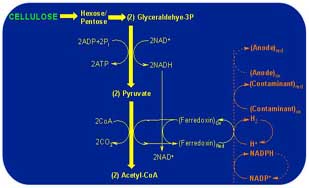 al energetic output by allowing sustained operation of the MFC in batch mode. The project is also novel because it uses pure culture MFCs instead of the commonly used mixed culture MFCs. This facilitates the application of metabolic flux analysis tools, which can create highly controlled model systems for better MFC system optimization and control.
al energetic output by allowing sustained operation of the MFC in batch mode. The project is also novel because it uses pure culture MFCs instead of the commonly used mixed culture MFCs. This facilitates the application of metabolic flux analysis tools, which can create highly controlled model systems for better MFC system optimization and control.
Progress
A survey of the literature relevant to pure culture MFCs materials and measurement techniques was completed. Following the initial literature survey, an initial set of pure-culture autoclavable MFCs were designed and fabricated in polymeric materials and in glass. In addition to this, brush anodes were designed and fabricated using carbon fiber and titanium wire. Testing of different anodes, cathodes, and membrane-electrode assemblies with biological cultures is poised to begin in the near future. Manuscript of a review paper dealing with biopolymer use in MFCs is currently under preparation.
Last updated 9/3/2009 Back to Top
Systems Projects
Commercial Aviation in a Carbon Constrained Future: Effective Technological, Operational and Policy Responses from an Enterprise of Enterprises View
Aviation is a key enabler of the globally integrated economy, but is a rapidly growing emitter of greenhouse gas emissions that contribute to climate change. As a result of its carbon intensity, the aviation enterprise is facing substantial challenges as fuel prices increase dramatically while its carbon emissions are likely to be regulated by a global carbon trading regime in the post-Kyoto agreement.
For the Middle East, commercial aviation is registering very high growth rates and is central to sustaining economic growth. These growth rates, aside from creating conditions for a potential glut in airport and aircraft capacity, may also leave the airlines and airports in the M.E. unprepared in the face of carbon management policies or changes in the public perception of air travel.
 Principal Investigator at MIT: Professor R. John Hansman
Principal Investigator at MIT: Professor R. John Hansman
 Principal Investigator at Masdar Institute: Assistant Professor Sgouris Sgouridis
Principal Investigator at Masdar Institute: Assistant Professor Sgouris Sgouridis
Research Objectives
- Map the trade-space of options available to reduce greenhouse emissions of commercial aviation.
- Model the impact of the different policy and business strategies and identify those that are more effective
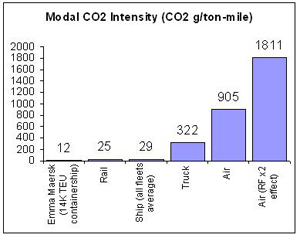
Impact on Global Sustainability
- Show a pathway towards a more sustainable aviation sector
- Create modeling tools and a knowledge database that would allow informed policy decisions and business strategies that are robust under different possible future scenarios.
Approach
Our research approach is based on a two pronged effort:
- qualitative research in the form of interviews with industry leaders and extensive literature reviews to provide insights into the primary interactions among stakeholders and their internal decision-making processes, and;
- development of system dynamics and agent-based models to provide quantitative demonstrations of the impact of different public policies and business strategy.
Progress
- Interviews and the modeling process are under way.
- Extensive literature review complete.
- Baseline experiments using a modified existing commercial aviation model have been conducted.
- Design of the architecture for a new generation of models that would allow regional differentiation between airlines as well as internalize the carbon markets and fuel price feedback loops is underway.
Last updated 9/25/2008 Back to Top
A High Efficiency and Environmentally Friendly Nuclear Reactor for Electricity and Hydrogen
This project will examine approaches for evolution of the design of nuclear power plants to address future needs of electricity, drinkable water, and hydrogen through a highly efficient and environmentally friendly reactor (HEER). HEER will have high power conversion efficiency, with minimum production of spent fuel and waste. This advanced reactor will utilize innovative fuel designs to enable efficient fuel utilization and heating the coolant to a higher temperature in an integral vessel for the reactor and steam generation to maximize the power plant efficiency and safety. A reduction in the spent fuel production rate by a factor of two or more in comparison to today's reactors in Europe and Japan is anticipated. Finally, to be ready for deployment in the Middle East, the new reactor concept has to exhibit an added level of proliferation resistance.
 Principal Investigators at MIT: Professor Mujid S. Kazimi and Dr. Pavel Hejzlar
Principal Investigators at MIT: Professor Mujid S. Kazimi and Dr. Pavel Hejzlar

 Principal Investigator at Masdar Institute: Professor Youssef Shatilla
Principal Investigator at Masdar Institute: Professor Youssef Shatilla
Research Objectives
The project intends to examine the use of novel reactor designs using water-cooled reactors or salt-cooled reactors. A comparison of the various features of the new concepts will be performed.
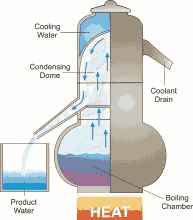
Impact on Global Sustainability
Addressing future needs of electricity, drinkable water, and hydrogen through the redesign of nuclear power plants to a highly efficient and environmentally friendly reactor (HEER).
Approach
- Extend the core power density to the extent possible within the same, or even an improved, safety margin using annular fuel instead of solid fuel.
- Increase the fuel initial enrichment from the current 5% to the maximum allowed civilian fuel enrichment of 20% while maintaining the appropriate burnable poisons to manage the neutronic reactivity in the core. This should allow the reduction of the fuel volume by a factor of two or more and increase the efficiency for electricity production while maintaining attractively high power density.
Progress
Liquid Salt Thermal Reactor
The preliminary LSR assembly was designed in three steps. First, the hydride fuel was selected from various existing designs which also provided their thermal and mechanical properties. It was identified that the UZrH concept prevailed over the hydride fuels which included Th in terms of cycle length. Thus, the hydride fuel design with the highest concentration of U-235 was selected. SiC was selected as the preliminary cladding material because of its neutronic transparency and lack of metals which contribute to corrosion. LiF-NaF-BeF2 was selected as the coolant from fluoride salt candidates based on criteria of low melting temperature and neutronic and thermal hydraulic properties such as heat capacity and neutron capture cross sections. The core was then designed primarily based on thermal hydraulic constraints. A power density of approximately 45 kW/l was achieved by selecting a 7mm OD pin, and a hexagonal wire wrapped pin lattice. Due to the low power density it is possible to cool the core with relatively low primary coolant flow, resulting in a pumping power, less than 1% of the electrical output of the power cycle. Under a relatively low power density, the proposed assembly design has a cycle lifetime of 13+ years and a slightly positive coolant temperature coefficient which is dominated overall by a negative Doppler coefficient.
Medium Power Superheat Boiling Water Reactor
Nuclear superheat is an attractive approach to appreciably increase thermal efficiency of BWRs, reduce the cost of generating electricity, and improve fuel utilization as well as reduced spent fuel per generated unit of energy. However, the design of superheat BWRs with the integral nuclear superheater, which is most cost-effective among various superheat concepts, faces a number of design challenges in fuel element design, reactor stability and materials that need to be overcome before the successful concept can be developed and deployed. Previous designs and concepts have been reviewed. All these reactors were small and had low power level since they were intended to provide a demonstration of the concept. Unfortunately, due to mechanical failures, poor economy and other reasons, all these superheat nuclear reactors have been shut down and decommissioned. In spite of the early problems, the design of a superheat BWR, using today's technology and materials, deserves a new look. We believe that the mechanical failures encountered in the early days of the 60's and 70's can be solved by using the advanced materials. In addition, the improved water chemistry, stronger computational capability, better understanding of the neutronic and thermal-hydraulic principles will be beneficial in overcoming the early issues and in identification of more efficient BWR design.
Thus far, three designs for medium power BWR cores with innovative core arrangements have been proposed. The first one is a "multi-region" core arrangement. The second proposed design has a "checkerboard" core arrangement. The third proposed design has an "all-in-one" core which combines the boiler and superheater into an entity.
Medium Power High Power Density PWR
Much of this period's work has been focused on the implementation of high performance annular fuel to the water cooled and compact IRIS reactor, whose modified design would be ideal to fulfill the goals of the project's novel medium-sized reactor concept. Extensive work on PWRs using annular fuel had been done at MIT, but before the fuel can be applied to other designs, two remaining issues from the PWR annular fuel project had to be resolved: 1) the inadequate shutdown margin due to higher enrichment and 2) the fuel's inner channel flow constriction due to blockage and oxide growth.
The first issue was resolved by changing the control rod material from Ag-In-Cd to 25% B10-enriched B4C. Using the CMS code package, a 3411 MWt Westinghouse PWR using annular fuel and the enriched boron control rods was calculated to be able to maintain a shutdown margin above the minimum of 1.3%Δρ throughout the fuel’s in-core lifetime. With this lingering issue resolved, the neutronic feasibility of applying annular fuel to PWRs was fully demonstrated.
To ensure the thermal-hydraulic feasibility of using annular fuel on PWRs, the issue of flow constriction of the fuel's inner coolant channel was addressed under two circumstances: 1) partial blockage of the channel inlet and 2) axial crud and oxide growth along the inner channel. Using the thermal-hydraulics code VIPRE, and under very conservative assumptions, an annular fuel core was calculated to be able to maintain a MDNBR of 1.3 with an oxide and crud layer thickness of 30μm, a typical thickness seen on PWR fuel at EOC. Under the more realistic assumption, the fuel was found to be able to maintain the 1.3 MDNBR with a 35%-40% blockage of the inner channel entrance.
Last updated 9/25/2008 Back to Top
Integration of Renewable Energy Sources in Power Systems - Electricity Markets and Microgrid Reliability
This project examines the challenges of integrating high penetrations of distributed and intermittent renewable energy sources, such as solar photovoltaics and wind power, into modern power systems. Two interrelated areas are covered: 1) operation and control of micro-grids to better exploit distributed resources, and 2) modification of power market rules and mechanisms to reduce the costs of deploying intermittent renewable energy technologies in microgrids. The role of energy management systems and energy storage in enabling more controllable microgrids that are responsive to dynamic pricing is another key component.
 Principal Investigator at MIT: Professor James Kirtley
Principal Investigator at MIT: Professor James Kirtley

 Principal Investigators at Masdar Institute: Associate Professor Scott Kennedy and Assistant Professor Hatem Zeineldin
Principal Investigators at Masdar Institute: Associate Professor Scott Kennedy and Assistant Professor Hatem Zeineldin
Research Objectives
- Evaluate impact of intermittent resources and demand response technologies on electricity markets.
- Devise new market rules and mechanisms for micro-grids with distributed generation
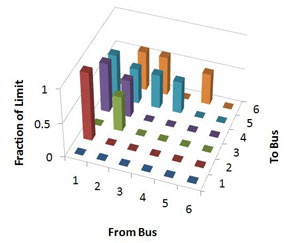
Impact on Global Sustainability
- Reduction of integration costs for intermittent renewable energy.
- Support rapidly growing electricity demand with high penetration of renewable energy.
Approach
The approach involves running coupled simulations between power system operation and sequentially clearing power markets. Optimal power flow and unit commitment problems are solved for testing different distributed generation technologies under a range of grid topologies and transmission capacity limitations. Interesting topics currently under examination are the impacts of stochastic distributed energy resources on microgrid reliability, new demand-side bidding mechanisms for increased price responsiveness of electricity demand, the potential participation of wind or solar power providers in ancillary service markets, and the financial arrangements that would guide operation of micro-grids.
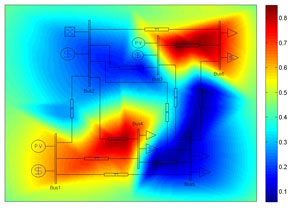
Progress
- Developed model to assess nodal price variations due to variable wind input.
- New approach for adding demand response to economic dispatch
- New methodology proposed for evaluating reliability of microgrids with stochastic local generation
Last updated 9/25/2008 Back to Top
Technology Forecasting Using Data Mining and Semantics
The planning and management of research and development activities is a challenging and data-intensive task. Research managers often rely on intuition and domain knowledge to arrive at management decisions. While the role of expert opinion in decision making cannot be discounted, it still has a number of problems:
- Expert decisions are subjective
- Suitably qualified experts are difficult to identify and the associated costs are high
- Recording the reasons for and contexts in which decisions are made are difficult
This project focuses on the use of data mining and context mediation tools as a means of enriching this process via the incorporation of empirical information.
 Principal Investigator at MIT: Professor Stuart Madnick
Principal Investigator at MIT: Professor Stuart Madnick
 Principal Investigator at Masdar Institute: Assistant Professor Wei Lee Woon
Principal Investigator at Masdar Institute: Assistant Professor Wei Lee Woon
Research Objectives
- Apply data mining and semantic techniques to scientific databases
- Predict and analyze the development of technological fields
- Conduct a case study on renewable energies and sustainability
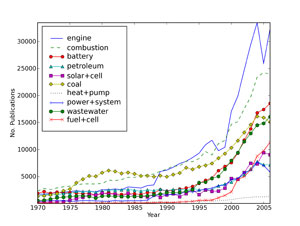
Impact on Global Sustainability
Technology-mining methods may ultimately predict the evolution of technological growth.
Approach
Use a novel combination of data-mining and context-mediation techniques for improved performance
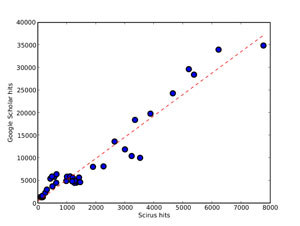
Progress
The focus so far has been on the development of tools which will support the execution of the rest of the project. This includes: The identification of databases suitable for conducting preliminary investigations; while the long term aim is to study data extracted from a variety of sources, the initial focus is on academic databases and blog search engines.
The development of methods for automatically visualizing and understanding research “landscapes” based on publication patterns in the academic literature. Initial results indicate that:
- Data from online databases are noisy and might result in inconsistent findings, even though the sources of these sites may overlap significantly.
- Particularly, it is very difficult to compare results from academic and blog databases as information from these sources occur over very different time-scales.
- Visualization and clustering tools appear to be effective in grouping related research themes and topics.
Last updated 9/25/2008 Back to Top
Requirements Engineering for Sustainable Systems
Software can play a major role in enabling and optimizing sustainability for large classes of systems. Unfortunately, up to now, sustainability has been largely ignored by stakeholders. And not just stakeholders -- engineers, themselves, are largely untrained and unable to properly take into account and solve sustainability-related problems.
The first step toward systematically solving this problem is by tackling sustainability issues at the requirements engineering level. Proper requirements engineering for software-based sustainable systems is crucial for building sustainable systems that successfully satisfy stakeholders' needs and at the same time handle sustainability constraints. As such, building sustainable systems raises a number of new requirements engineering challenges.
 Principal Investigator at MIT: Professor Olivier L. de Weck
Principal Investigator at MIT: Professor Olivier L. de Weck
 Principal Investigator at Masdar Institute: Assistant Professor Davor Svetinovic
Principal Investigator at Masdar Institute: Assistant Professor Davor Svetinovic
Research Objectives
- Discover the unique requirements engineering challenges with respect to the development of sustainable systems
- Define a general requirements engineering meta-model and framework that will facilitate the analysis and specification of sustainability-related requirements. Focus on the special role of software in achieving sustainable systems
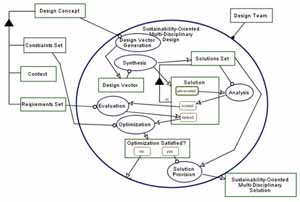
Impact on Global Sustainability
- Provide a framework of reusable sustainability-related requirements that reduces development cost for the new projects and increases stakeholders' satisfaction
- Provide means for systematic capture and modeling of sustainability-related requirements
- Increase engineers' understanding and capability for successful management and implementation of the sustainability-related requirements
Approach
- Literature Review and Sense-Making
- Data Gathering and Interviews
- Modeling and Simulation
- Synthesis of Meta-Model and Framework for Sustainable Requirements Engineering
Progress
- Conducted literature review to examine the core sustainability area Conducted literature review to examine the sustainability-related requirements engineering areas
- Obtained a set of the high-level Masdar City specification documents
- Obtained a set of the high-level Masdar City Rapid Transportation System specification documents
- Developed a general process using a generic systems modeling language based on bi-partite graphs (objects, processes) and formal language to develop a Sustainability-Oriented Multi-Disciplinary Solution set from the initial set of the requirements [See figure above].
Last updated 2/06/2009 Back to Top
Greening the Supply Chains: Optimization Models and solution algorithms
This project focuses on developing mathematical programming models to investigate the impact of new environmental legislations on product supply chains, including regulations to reduce carbon dioxide emissions, waste, and the use of nonrenewable inputs. Most of the resulting models are NP-hard combinatorial optimization problems and are practically too difficult to solve optimally.Therefore, several heuristic techniques that aim to find near-optimal or high-quality solutions within a reasonable computation time will be developed. Using these fast techniques we will be able to conduct sensitivity analysis that is helpful in making robust decisions especially under the existence of uncertainty in the models' parameters.
 Principal Investigator at MIT: Professor David Simchi-Levi
Principal Investigator at MIT: Professor David Simchi-Levi
 Principal Investigator at Masdar Institute: Assistant Professor Ali Diabat
Principal Investigator at Masdar Institute: Assistant Professor Ali Diabat
Research Objectives
- The development of tools and techniques that enable modeling and analysis of the interaction between supply chain and environmental management.
- Application of these tools to understand critical tradeoffs and alternatives in controlling supply chain carbon footprint.
Impact on Global Sustainability
- Helping business stakeholders to understand the environmental impacts related to their supply chain strategies and practices.
- Providing tools for enabling consumers to understand the environmental impacts associated with different products.
- Reducing environmental impacts from supply chains by means of providing an incentive to suppliers to differentiate their products.
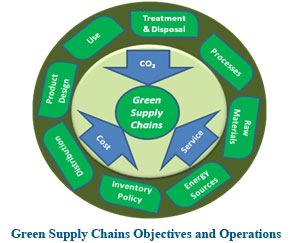
Approach
- Integer programming
- Stochastic programming
- Multi-objective optimization
- Lagrangian relaxation
- Benders' decomposition.
- Heuristics algorithms.
Progress
- Current major focus is on conducting a thorough literature review on managing CO2 emissions in a supply chain context.
Last updated 2/27/2008 Back to Top
Intelligent Devices for Smart Power Grids
Since renewable power generation often produces unpredictable and time-varying electricity capacity, power grids employing these technologies must maintain large reserves of generation capacity to ensure that supply does not exceed demand. This reserve generation capacity is expensive to purchase, build, and maintain. Additionally, due to the unpredictable nature of renewable generation, reliance must sometimes be placed on more traditional energy sources that leave large carbon footprints. The cost of reserve generation capacity in Masdar City and other energy grids can be reduced or eliminated in several ways. First, more efficient and cost-effective power generation technologies can be developed. Second, technologies for effectively storing excess electricity within the power grid can be developed in order to offset the effects of time-varying generation capacity. Third, demand-side management strategies, or demand response, can be implemented to reduce energy demand during periods in which supply threatens to exceed demand. This research will focus on using demand response to reduce generation capacity requirements.
 Principal Investigator at MIT: Professor Munther A. Dahleh
Principal Investigator at MIT: Professor Munther A. Dahleh
 Principal Investigator at Masdar Institute: Assistant Professor Jacob W. Crandall
Principal Investigator at Masdar Institute: Assistant Professor Jacob W. Crandall
Research Objectives
We will develop and analyze autonomous devices for distributing, acquiring, and managing electricity resources in networked power grids. This will involve developing artificial 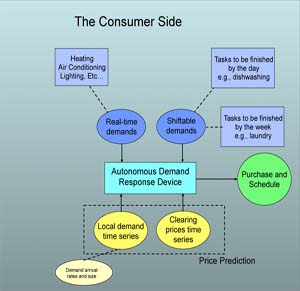 learning and control algorithms and human-machine interaction technologies that allow users to effectively manage, distribute, and acquire energy resources.
learning and control algorithms and human-machine interaction technologies that allow users to effectively manage, distribute, and acquire energy resources.
Impact on Global Sustainability
Masdar City is designed to be a green and sustainable city that provides the highest quality of living to its inhabitants. A smart power grid powered by renewable energy sources is necessary to realize this ambitious goal. In particular, intelligent information technologies, such as the devices we will develop and analyze in this research, are essential to constructing a power grid that responds to fluctuations in supply and demand without inconveniencing inhabitants.
Approach
Creating the intelligence for such devices will require research in the following inter-related areas:
- Identifying and developing properties of current and future electricity markets in Masdar City, including:
a. Identifying the structure of the electricity market
b. Identifying the key entities in the electricity market
c. Identifying communication requirements and capabilities - Identifying and developing pricing mechanisms and incentives to minimize reserve supply.
- Modeling electricity demand and generation from user data.
- Developing distributed control/learning algorithms for both distributors and consumers.
- Developing human-device interaction methodologies that will allow users to effectively configure and teach their devices to satisfy their needs and preferences.
We will test and analyze the resulting intelligent information technologies via both simulation and user study. Ideally, this research will culminate in a user study and demonstration within Masdar City itself.
Last updated 8/04/200 Back to Top
Policy Projects
The Development of Innovative Industries and the Role of Public Research Institutions: The Case of Renewable Energy
Our project focuses on the role of research universities and other public research institutions in the development of innovative industries and the broader consequences for economic development, especially in the communities within which the research institutions are located. This research contributes to a better understanding of strategies for developing renewable energy industries worldwide, and of the capacity for innovation in the UAE region.
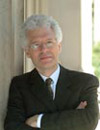 Principal Investigators at MIT: Professor Richard K. Lester and Professor Michael J. Piore
Principal Investigators at MIT: Professor Richard K. Lester and Professor Michael J. Piore

 Principal Investigator at Masdar Institute: Assistant Professor Georgeta Vidican
Principal Investigator at Masdar Institute: Assistant Professor Georgeta Vidican
Research Objectives
- Understand technological and institutional development trajectories in different locales.
- Develop new concepts, theory and vocabulary to explain innovation
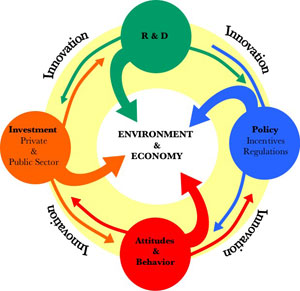
Impact on Global Sustainability
- Explore the process of diversification away from oil and gas into knowledge economies.
- Create an economic development strategy framework for public research institutions.
- Examine local innovation capabilities in sustainable technologies in the UAE.
Approach
We conduct a set of longitudinal, comparative case studies designed to trace the scientific, technological, and commercial development of different industries:
- Comparative studies of the development of solar photovoltaic (PV) industry in three leading centers of innovation (Massachusetts, California, Germany), with a focus on the role of public research institutions.
- Comparative studies on the specific role of MIT in the development of three different industries in Massachusetts (solar PV industry, energy services, batteries).
- Study of the specific economic and institutional context for innovation in the UAE by looking at efforts to diversify UAE’s economy.
Progress
- Conducted literature review to examine the pattern of development and technological innovation in the solar PV industry in the U.S.
- Mapped the value chain for the three generations of solar PV energy technology to better understand opportunities for innovation in the sector.
- Evaluated the institutional framework behind the development of the industry in the U.S. (i.e. legislation for R&D, tax incentives for market creation).
- Assessed and compiled the main federal and state incentives for technology development and market deployment in the U.S.
- Created a complete database of: (a) all the solar related companies in Massachusetts and California, at different stages in the value chain; (b) all the cell and module manufacturers worldwide, allowing us to assess the global dynamics in the solar PV sector.
- Designed the interview protocol for the semi-structured interviews with companies and researchers at universities and national laboratories.
- Conducted 45 interviews with representatives of industry and academia.
Last updated 9/10/2008 Back to Top
Integration of Renewable Energy Sources in Power Systems
The project focuses on topics related to the integration of renewable energy sources in power systems. Issues being investigated include: islanding detection, micro-grids, reliability and electricity market operation with renewable energy sources.
 Principal Investigator at MIT: Professor James Kirtley
Principal Investigator at MIT: Professor James Kirtley

 Principal Investigators at Masdar Institute: Assistant Professor Hatem Zeineldin and Associate Professor Scott Kennedy
Principal Investigators at Masdar Institute: Assistant Professor Hatem Zeineldin and Associate Professor Scott Kennedy
Research Objectives
- Develop control and protection schemes that will facilitate widespread integration of micro-grids.
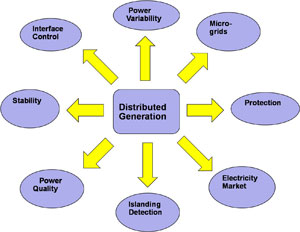
Impact on Global Sustainability
- Analyze and mitigate the impacts of renewable energy sources on power systems.
Approach
The first phase of the project focused on analyzing and designing new techniques for islanding detection. The analysis was further extended by examining the impact of load voltage and frequency dependence on islanding detection. The analysis was conducted using a digital simulator "PSCAD/EMTDC".
The second phase of the project will focus on the design of new control and protection schemes for distribution systems with high penetration of distributed generation. One of the tasks is to develop an efficient control strategy for facilitating micro-grid operation. The analysis will be conducted using PSCAD/EMTDC and CYME.
Progress
Some of the major accomplishments during the first phase of the project include:
- A new simple and easy to implement islanding detection method has been developed for inverter based Distributed Generation with negligible Non-detection Zones.
- The impact of load voltage and frequency dependence on the DG performance during an islanded situation has been analyzed.
- A literature review of existing microgrid control strategies and microgrid stability has been performed.
- A methodology has been developed for assessing the reliability of a microgrid that is operating in islanded mode with Stochastic Distributed Energy Resources (SDER).
Last updated 9/11/2008 Back to Top
Modeling and Predicting the impact of climate change on health in the middle east, south asia, and africa
This project investigates the impact of climate change on health in the Middle East, South Asia, and Africa (MESAA). We combine the estimated impacts of temperature on health outcome and health preserving consumptions with predicted changes in climate from "business as usual" scenarios to develop estimates of health related welfare cost of climate change in the region. Special attention is being paid to mortality as the health outcome, electricity consumption (for air conditioning) and water consumption as short-term adaptation measures, and migration as long-term adaptation measure.
 Principal Investigator at MIT: Professor Michael Greenstone
Principal Investigator at MIT: Professor Michael Greenstone
 Principal Investigator at Masdar Institute: Assistant Professor I-Tsung Tsai
Principal Investigator at Masdar Institute: Assistant Professor I-Tsung Tsai
Research Objectives
- Establish the relation between temperature and mortality, temperature and short-term as well as long-term
adaptation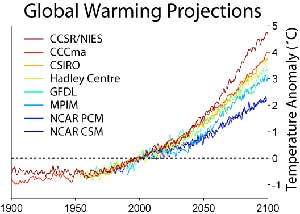 measures in the MESAA region
measures in the MESAA region - Predict the full welfare cost of climate change on health in the MESAA region by the end of this century under the business-as-usual scenarios
- Define the optimal carbon emission pace that mitigates health related welfare cost in the MESAA region.
Impact on Global Sustainability
- Facilitate the development of health policy in a region with greatest expected economic and population growth in the world.
- Facilitate the development of a global carbon emission policy that sustains human health in the MESAA region.
Approach
- Developing econometric models to estimate the impacts of temperature and precipitation on mortality, electricity consumption, water consumption, and migration.
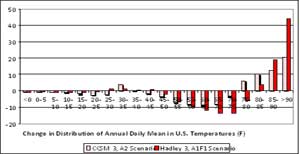
- Using predicted temperature and precipitation data from climate change models to forecast the impacts of climate change on health in the MESAA region.
Progress
- Current major focus is on data collection. We have derived quality data for most of the key variables we will be examining.
Modeling Technology Policy for Energy and Water: Applications and Extensions of System Dynamics
This project seeks to undertake a set of case studies on modeling technology policy in Abu Dhabi. The proposed cases will concentrate on energy and water, two critical sectors of the Emirate's economy, and utilize system dynamics as the primary modeling approach. Energy use is essential in the provision of water, resulting in close connections between energy and water. We concentrate on solar energy and on desalination and examine the relevant interconnections.
 Principal Investigator at MIT: Professor Nazli Choucri
Principal Investigator at MIT: Professor Nazli Choucri
 Principal Investigator at Masdar Institute: Professor Toufic Mezher
Principal Investigator at Masdar Institute: Professor Toufic Mezher
Research Objectives
- Develop model-based strategies to increase the knowledge intensity of economic activity
- Assist in positioning Abu Dhabi for long-term sustainable development
- Help resolve tension between competing demands on energy policy
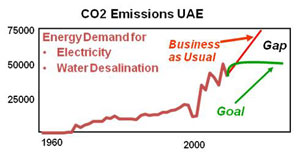
Impact on Global Sustainability
- Will move the Emirates toward energy sustainability, sustainable uses of energy in the water sector, and sustainable strategies for overall water provision.
- Control CO2 emissions
- Expand skills and capacity building
- Advance RE technologies
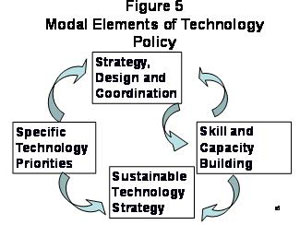
Approach
The scope of work for modeling technology policy (and implementation potentials) includes:
(a) the methodology (system dynamics), (b) the substantive research domain (solar energy and desalination technology), and (c) the knowledge management necessity Technology policy is a complex process. It always involves institutional, financial, managerial, material, policy and other factors that represent hard as well as soft variables. Given the inherent complexities and uncertainties, we will utilize system dynamics as the basic modeling approach.
In examining solar energy and desalination, we distinguish between traditional and emergent technologies, and consider the technology imperatives for sustainable development. Through this project, we consider the knowledge management requirements that are essential for harnessing knowledge of relevance and building upon as well as extending existing knowledge. Knowledge management is a term usually confined to the domain of information technology. Our focus on the systematic collection and organization of knowledge in this project pertains to the substantive materials that will constitute the fundamental knowledge-resources in the course of this project. This includes all (a) all background materials (b) case specific resources and (c) information, data, materials and reports developed in the course of this project.
Progress
- Reviewing the literature for framing model architecture
- Determination of data needs, compiling and organizing observations and information
- Customization of data compilation to Abu Dhabi required for modeling needs.
In addition, we are reviewing and evaluating the sustainability features essential for technical and institutional factors central to technology policy by: (1) identifying the different sustainable development policies implemented in different countries with emphasis on renewable energy and water, including desalination, (2) defining the organizational and technical elements for incorporation in the technology policy, (3) isolating the most salient barriers to impediments to the technology policy process as currently understood, and select those factors that are most relevant to Abu Dhabi, and (4) distinguishing between structural, behavioral and cognitive factors fundamental to the case studies.
Last updated 9/11/2008 Back to Top
